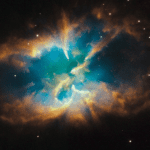 Weird Stuff
Weird Stuff  Weird Stuff
Weird Stuff  Our World
Our World 10 Ways Your Christmas Tree Is More Lit Than You Think
 Movies and TV
Movies and TV The 10 Coolest Stars to Set Sail on The Love Boat
 History
History 10 Things You Didn’t Know About the American National Anthem
 Technology
Technology Top 10 Everyday Tech Buzzwords That Hide a Darker Past
 Humans
Humans 10 Everyday Human Behaviors That Are Actually Survival Instincts
 Animals
Animals 10 Animals That Humiliated and Harmed Historical Leaders
 History
History 10 Most Influential Protests in Modern History
 Creepy
Creepy 10 More Representations of Death from Myth, Legend, and Folktale
 Technology
Technology 10 Scientific Breakthroughs of 2025 That’ll Change Everything
 Weird Stuff
Weird Stuff Ten Bizarre Facts About The Doge Meme
 Our World
Our World 10 Ways Your Christmas Tree Is More Lit Than You Think
 Movies and TV
Movies and TV The 10 Coolest Stars to Set Sail on The Love Boat
Who's Behind Listverse?

Jamie Frater
Head Editor
Jamie founded Listverse due to an insatiable desire to share fascinating, obscure, and bizarre facts. He has been a guest speaker on numerous national radio and television stations and is a five time published author.
More About Us History
History 10 Things You Didn’t Know About the American National Anthem
 Technology
Technology Top 10 Everyday Tech Buzzwords That Hide a Darker Past
 Humans
Humans 10 Everyday Human Behaviors That Are Actually Survival Instincts
 Animals
Animals 10 Animals That Humiliated and Harmed Historical Leaders
 History
History 10 Most Influential Protests in Modern History
 Creepy
Creepy 10 More Representations of Death from Myth, Legend, and Folktale
 Technology
Technology 10 Scientific Breakthroughs of 2025 That’ll Change Everything
10 Weird and Unsolved Mysteries of the Pacific Ocean
The Pacific Ocean is the largest and deepest of the five main oceans. We know that it covers about 32% of the earth’s surface. There are about 25,000 islands located inside of it, and it has the largest array of plants and animals than any other ocean in the world. There are thousands of things we do know about the Pacific, but there are still numerous mysteries that haunt the massive area of water, from unknown animals and sounds to strange disappearances. Here are ten unsolved mysteries of the Pacific Ocean.
Related: Top 10 Underwater Ruins Of Lost Civilizations
10 Underwater Volcanoes
One of the world’s largest volcanoes lies deep in the middle of the Pacific Ocean. The Havre volcano lies 3,000 feet (914 meters) below the sea’s surface, producing the largest deep-water eruption ever recorded. In 2012, lava rose from 14 separate vents and poured out for about 90 days. Even though the size of the eruption was massive, it almost went unnoticed. As a commercial airplane traveled over the ocean, a passenger spotted something odd in the water. The passenger contacted a geologist about what she saw, and it prompted a huge search in the ocean that led to the discovery of the volcanic eruption.
Surprisingly, about 70% of volcanic eruptions occur beneath the water, but scientists still have difficulty understanding these phenomena. These volcanic eruptions create different types of lava because pressure and the interaction between water and cooling magma aren’t the same as when a volcano erupts on the land. Scientists are still working to determine how these interactions form the different types of lava of an underwater eruption. The underwater eruptions tend to go unnoticed and can be very deep in the ocean, making it challenging for scientists to study them.[1]
9 Mariana Trench
The deepest oceanic trench on Earth is located in the western Pacific Ocean. The Mariana Trench is about 1,580 miles )2,542 kilometers) in length and is crescent-shaped. The deepest point of the trench is known as the Challenger Deep and sits at the southern end of the trench, about 36,089 feet (11,000 meters) deep. Just to show the magnitude of its depth, the Mariana Trench is also deeper than Mount Everest is tall.
The Mariana Trench is still very much a mystery because of the difficulty of reaching such depths. This is one of the most remote and unreachable places on Earth, with only a handful of attempts to reach the bottom to study the maritime environment. Most recently, the submersible Deepsea Challenger was piloted by filmmaker James Cameron and reached a record depth of 35,754 feet (10,898 meters). Even with these challenges, scientists continue to explore the mysteries hiding in the depths of the Mariana Trench.[2]
8 Deep-Sea Monsters
Several deep-sea giants have been discovered in the ocean, but scientists believe there are still many deep-sea monsters lurking in the depths of the Pacific Ocean. As you dive deeper into the ocean, the pressure rises immensely, lowering the temperature to near freezing. This creates a hostile environment that houses animals we can only imagine. There are several rumors of giant squids, monster whales, and other unknown large sea animals lurking beneath the surface of the Pacific Ocean.
In January and February of 2024, a Pacific Ocean expedition off the coast of Chile uncovered more than 100 unknown marine species. The new species discovered included sea urchins, mollusks, and lobsters. Scientists say that fully identifying the species found could take several years. Still, these expeditions are important to help advance the knowledge of life that is on Earth. Even though this expedition didn’t reveal any new giant monsters, it doesn’t mean the next one won’t.[3]
7 Ghost Ships
A ghost ship is a vessel with no crew aboard found drifting in the ocean. Some stories of ghost ships are just eerie tales with no supporting facts, but real ghost ships have been discovered in the Pacific Ocean. In 1955, all 25 passengers aboard the American merchant ship MV Joyita mysteriously vanished. The ship was later found adrift in poor condition with no one aboard. Several theories for the passenger’s disappearances have been talked about, including insurance fraud, a Japanese attack, and even a mutiny, but their disappearance is still a mystery.
In 2021, an underwater volcano raised two dozen ghost ships from the Pacific Ocean near Tokyo. The 24 ships were sunk by U.S. forces in the Battle of Iwo Jima during World War II. The ships were captured by the U.S. Navy and purposefully sunk parallel to the shoreline to form a breakwater for protection. There are likely more ghost ships waiting to find their way to the top of the ocean, which will create more mysteries that need to be solved.[4]
6 Yonaguni Monument
The Yonaguni Monument is a fascinating underwater structure located off the coast of Yonaguni Island, Japan, that has captured the attention of researchers and adventurers alike. Discovered in 1986 by a diver, this submerged formation consists of massive flat terraces, sharp right angles, and pillars, resembling a man-made structure. However, its origins remain a mystery.
Some geologists argue that the monument is a natural formation resulting from tectonic activity and erosion over thousands of years. Others believe it could be the remains of an ancient civilization, possibly submerged due to rising sea levels around the last Ice Age, over 10,000 years ago. Supporters of the artificial theory point to the structure’s straight edges and apparent carvings as evidence of human craftsmanship.
Regardless of its origin, the Yonaguni Monument continues to intrigue explorers and researchers. It has inspired numerous theories and debates about whether it represents a lost chapter of human history, perhaps even an ancient Pacific civilization similar to Atlantis. The monument’s enigma, submerged beneath the ocean, remains one of the greatest unsolved mysteries of the Pacific Ocean.[5]
5 Mysterious Sounds
The National Oceanic and Atmospheric Administration, also known as NOAA, has been investigating mysterious sounds from the Pacific Ocean for years. The Bloop, the Upsweep, and the Slow Down are a few of these puzzling sounds that have been recorded. The NOAA uses hydrophones positioned in various places of the ocean to collect digital records of sounds in the ocean.
The Bloop was an ultra-low frequency detected by the NOAA in 1997. The mysterious underwater sound was thought to either be from an ice quake or an unknown living creature. The Upsweep was discovered in 1991 by NOAA after detecting a train of narrowband upsweeping sounds. It can still be heard during the spring and fall, but the origin is still a mystery. These are just a few of the spooky sounds from underwater that are unknown to scientists.[6]
4 Vanished Islands
We’ve all heard of the tale of Atlantis, but there are other islands that have mysteriously vanished in the Pacific Ocean. The island of Teonimanu, part of the Solomon Islands, disappeared hundreds of years ago after rapidly sinking. Most likely, the island was destroyed after being affected by a large underwater volcano. It triggered a massive landslide, causing part of the island to shift underwater. Then, large tsunami waves trampled the sinking island.
In 1774, Captain James Cook charted the island of Sandy, and it was recorded in Cook’s Chart of Discoveries Made in the South Pacific Ocean. The island was mentioned again in 1876 after the ship Velocity reported Sandy Island as well, and it was then reported on several maps. The island was even spotted on Google Maps until just recently.
In 2012, Australian scientists failed to locate Sandy Island and recorded ocean depths of no less than 4,300 feet (1,310 meters), where it should have been. Was the island ever there? Did it mysteriously vanish? No one actually knows the truth about Sandy Island, making it one of the biggest mysteries of the Pacific Ocean.[7]
3 Great Pacific Garbage Patch
The Great Pacific Garbage Patch is a large patch of marine debris floating in the Pacific Ocean. Its name would lead you to think that it was a large island full of Coke bottles, burger wrappers, and other garbage floating together, but it is actually mostly made up of tiny bits of plastic called microplastics. These microplastics aren’t always visible to the naked eye, and they tend to make the water look soupy. They are formed from plastic bottles and other plastics that start breaking down but never actually dissolve. About 70% of the garbage ends up underwater at the Great Pacific Garbage Patch.
Scientists don’t know how much debris makes up the area because it is too large to net and work around. Since the area of marine debris is far from all nations, nobody wants to spend money to help clean it up. The biggest mystery dealing with the garbage patch is how it will affect the ocean and marine life. We know the floating island of garbage isn’t good for the ocean, but scientists are still determining just how bad the environmental implications could be in the future.[8]
2 Disappearances
The Pacific Ocean is home to several mysterious disappearances, but the most well-known is Amelia Earhart’s plane crash. The plane wreckage was never located, but it is believed that she crashed over the Pacific after running out of fuel. Carlo Giuseppe Bertero, an Italian physicist, mysteriously disappeared on a voyage from Tahiti to Chile. Mildred Doran and William Portwood Erwin were pilots who disappeared two days apart during the famous Dole Air Race. Other notable people who mysteriously vanished in the Pacific include Charles Ulm, Richard Halliburton, Paul Mooney, Theodore Kara, and Gerry Roufs.
The Pacific Ocean is also home to the Devil’s Sea, where many planes and ships have mysteriously vanished. The location of the Devil’s Sea is off the coast of Japan. Some explanations from scientists for the strange disappearances in the area include underwater volcanoes, methane hydrates, hot and cold currents causing turbulence, and seismic activity. Still, many of the incidents in the area remain a mystery.[9]
1 Lost Continent of Mu
Some people believe the long-lost continent of Mu, also known as Lemuria, once existed in the Pacific Ocean between 10,000 and 50,000 years ago. They think that more than 60 million people called Mu home, and those people belonged to a civilization known as Naacal. Mu was first mentioned in the works of British-American writer Augustus Le Plongeon. He believed that Egypt and Mesoamerica were created by refugees from Mu.
The lost island of Mu was then later mentioned by James Churchward in many of his writings. He believed the continent was positioned somewhere between Easter Island and Marianas from east to west, and it was somewhere between Hawaii and Mangaia from north to south. He claimed that a series of earthquakes and volcanic eruptions caused the continent to be destroyed. Geologists do not believe in the myth of Mu because they think it is impossible for a continent to be destroyed in that short period.[10]








